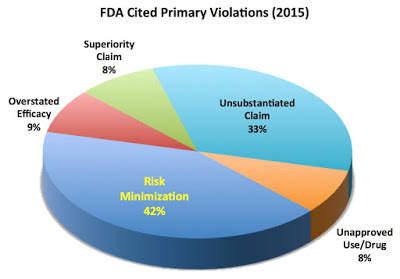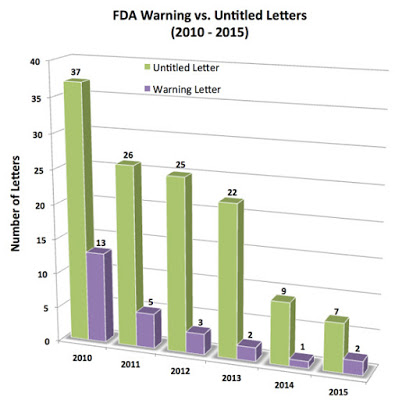As mentioned in a previous post, the FDA’s Office of Prescription Drug Promotion (OPDP) issued the fewest ever enforcement letters regarding non-biologic Rx drug promotions in 2015 (read “2015 Was Another Good Year for Orphan Drugs & Pharma Marketers“).
Of the 9 letters OPDP sent to drug companies regarding violations, 2 were serious “Warning Letters” and 7 were “Untitled Letters.” The following chart shows the Warning vs. Untitled letter trend from 2010 through 2015.
One Warning Letter went to Duchesnay for the promotion of Diclegis via Instagram. FDA cited 2 violations: (1) Omission of Risk Information (see “OMG. Kim Kardashian Shills for Pharma! No Worry – No Side Effects!“) and (2) Omission of Material Fact (the post failed to provide material information regarding DICLEGIS’ full approved indication, including important limitations of use). The other Warning Letter went to a Valeant subsidiary for the promotion of Tussicaps. FDA cited 3 violations: (1) Omission of Risk Information, (2) Inadequate Communication of Indication, and (3) Unsubstantiated Claims.
Deeper analysis reveals which violations reigned supreme.
Overall, there were 12 primary violations plus 6 other violations (including inadequate communication of indication, omission of material fact, and lack of adequate direction for use). Risk Minimization/Omission was the most often cited violation followed closely by Unsubstantiated Claim.
NOTE: This analysis does not include letters sent by the Advertising and Promotional Labeling Branch (APLB) of the FDA. APLB regulates the advertising and promotional labeling materials for CBER products (biologics). In 2015, APLB sent one (1) Untitled Letter to Protein Sciences Corporation regarding a video promotion of Flublok anti-flu vaccine. The letter cited a Misleading Efficacy Claim (the video misleadingly implied that the higher antigen content of Flublok translates into greater protection) and Omission of Risk Information (the video failed to present any important safety information from the package insert).
ADDENDUM: According to Mark Senak, author of EyeOnFDA blog, the decline may reflect the FDA’s “unfinished work” in formulating guidelines for digital media. This is an ongoing issue that has flummoxed drug makers, who are grappling with ways to harness social media to reach consumers while trying to avoid regulatory infractions. Read more about that here: “Is FDA So Digitally “Flummoxed” It Doesn’t Send Out Violation Letters?“










![6 Digital Tools at the Center of Healthcare Digitalization [INFOGRAPHIC]](http://ec2-54-175-84-28.compute-1.amazonaws.com/pharma-mkting.com/wp-content/uploads/2021/04/6DigitalTools_600px-100x70.jpg)




